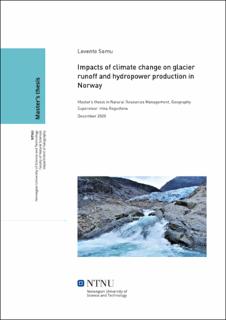| dc.contributor.advisor | Rogozhina, Irina | |
| dc.contributor.author | Samu, Levente | |
| dc.date.accessioned | 2021-09-28T17:55:21Z | |
| dc.date.available | 2021-09-28T17:55:21Z | |
| dc.date.issued | 2020 | |
| dc.identifier | no.ntnu:inspera:66377857:34393992 | |
| dc.identifier.uri | https://hdl.handle.net/11250/2785206 | |
| dc.description.abstract | Klimaendringer forårsaket av menneskelig aktivitet utgjør en stor trussel mot ferskvannsressurser over hele verden. Til tross for at bare en brøkdel av Jordas ferskvann er lagret i isbreer, bidrar bresmelte betraktelig til sommervannføringen i fjellområder i blant annet Sentral-Asia, Sør-Amerika og Europa. Kryosfæren er blant de mest følsomme deler av Jordas overflate og den kan raskt forandre seg i takt med global oppvarming. Det er derfor et stort behov for å vurdere mulige konsekvenser av endringer i avrenning av smeltevann fra isbreer i bebodde områder.
Denne studien tar for seg fire nedslagsfelt i Norge som er i stor grad dekket av isbreer og belyser endringene i avrenning av smeltevann. Det blir også gjort en nærmere undersøkelse på mulige konsekvenser av slike endringer på vannkraftproduksjonen. Studien tar i bruk fysisk geografisk data i form av observasjoner, klimamodeller og simulasjoner av massebalanse for å rekonstruere fortidens avrenningsmønstre samt forutsi hvordan mønsteret blir i fremtiden. I tillegg blir det brukt samfunnsgeografisk data i form av semistrukturerte intervju med vannkrafteksperter for å anslå effekten av endringer i avrenning på vannkraftindustrien.
De fire isbreene hadde stabil massebalanse og lengde i perioden 1960-1990, mens det tidlig på 90-tallet skjedde økning i utbredelse og masse. Denne vekstperioden var etterfulgt av negativ balanse og betydelig tilbakegang på alle fire nedslagsfelt, men netto avregning har økt i det siste. Denne økningen skyldes et større bidrag fra bresmelte, i tillegg til økt nedbør. Bresmelte bidro i størst grad i basseng med betydelig “climate continentality” hvor avrenningsmønstre er sterkt påvirket av temperaturendringer men ikke av nedbør.
Beregninger for fremtiden i to ulike scenarioer tyder på at avrenning vil forbli relativt stabil i “representative concentration pathway” (RCP) 4.5, mens det i RCP 8.5 vil øke ved de fire områdene i det 21. århundret. Det relative bidraget fra både bresmelte og snøsmelte til den totale avrenningen er estimert å avta, mens bidraget fra nedbør forventes å øke. Disse estimatene stemmer overens med de beregnet temperaturendringene for den samme tidsperioden. Beregninger for fremtiden og opplysninger fra intervjuene tyder på at isbreer kommer til å ha en moderat effekt på vannkraftproduksjon i Norge i det 21. århundret. En økt forekomst av perioder med tørke i sommertid kan allikevel føre til en enda større rolle av bresmelte i vannkraftproduksjon i fremtiden. | |
| dc.description.abstract | Human-made climate change poses a significant threat to freshwater resources worldwide. Despite the fact that mountain glaciers contain only a minor share of the planet’s freshwater, glacier melt provides invaluable contributions to the summer river discharge in many mountainous regions, such as Central Asia, South America and Europe. Since the cryosphere is among the most sensitive and rapidly responding components of the Earth’s surface under warming climate conditions, there is a substantial motivation for assessing potential impacts of change in glacier runoff regimes on societies in regions with high glacier cover.
This study sheds light on the past and future changes in runoff regimes of four highly glacierized catchments in Norway, zooming in on possible impacts of such changes on hydropower production. It builds upon an interdisciplinary approach that merges the physical and social branches of geography. Historical reconstructions and future projections of glacier runoff are based on a fusion of observational data, climate models and surface mass balance simulations, whereas semi-structured open-ended interviews with hydropower experts aim at estimating probable impacts of predicted changes in runoff regimes on the hydropower industry.
The four glacier systems addressed in this study exhibited stable mass-balance and length characteristics between the 1960s and 1990, followed by a period of general advance and mass gain in the early1990s. However, negative annual balances and significant retreat have dominated every studied glacier catchment since 2000. In the four study basins central to this thesis total runoff has increased in the recent past, albeit with a more significant rise and larger variations within marine-proximate catchments. The reconstructed general increase in the total runoff is in part due to an enhanced contribution of glacier melt and in part due to higher precipitation. In particular, a more substantial contribution of glacier meltwater to total runoff is found in basins with substantial climate continentality, where runoff regimes are strongly influenced by variations in temperature and much less so by changes in precipitation.
Future projections under two greenhouse gas concentration scenarios suggest that runoff will remain relatively stable for the representative concentration pathway (RCP) 4.5 and will show moderate increases for RCP 8.5 at the four study sites during the 21st century. The relative contributions of both glacier melt and snowmelt to the total runoff are estimated to drop, as opposed to a significantly increased share of rain in every catchment, which aligns well with the projected temperature changes during the corresponding period suggesting a strong correlation between the two. Future projections and interviews with hydropower experts indicate that glaciers will likely have a moderate impact on hydropower production in Norway in the 21st century. However, a more frequent occurrence of unusually dry periods during the summer periods may elevate the importance of glacier meltwater for hydropower production in the future. | |
| dc.language | | |
| dc.publisher | NTNU | |
| dc.title | Impacts of climate change on glacier runoff and hydropower production in Norway | |
| dc.type | Master thesis | |
